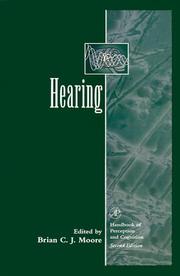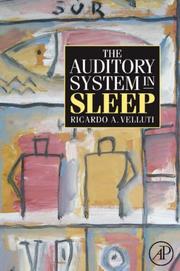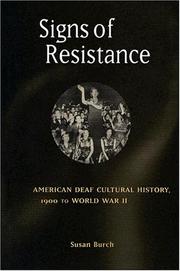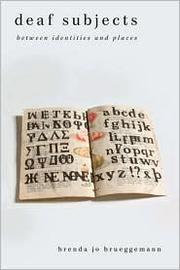| Listing 1 - 10 of 20 | << page >> |
Sort by
|
Book
Year: 2017 Publisher: London, United Kingdom : Academic Press/an imprint of Elsevier,
Abstract | Keywords | Export | Availability | Bookmark
 Loading...
Loading...Choose an application
- Reference Manager
- EndNote
- RefWorks (Direct export to RefWorks)
"Hearing Loss: Causes, Prevention, and Treatment covers hearing loss, causes and prevention, treatments, and future directions in the field, also looking at the cognitive problems that can develop. To avoid the "silent epidemic" of hearing loss, it is necessary to promote early screening, use hearing protection, and change public attitudes toward noise. Successful treatments of hearing loss deal with restoring hearing sensitivity via hearing aids, including cochlear, brainstem, or midbrain implants. Both the technical aspects and effects on the quality of life of these devices are discussed. The integration of all aspects of hearing, hearing loss, prevention, and treatment make this a perfect one-volume course in audiology at the graduate student level. However, it is also a great reference for established audiologists, ear surgeons, neurologists, and pediatric and geriatric professionals"--Publisher's description.
Deafness. --- Neoplasms --- Hearing disorders. --- Deafness --- Hearing disorders --- Prevention. --- Treatment.
Book
ISBN: 9781914386374 Year: 2023 Publisher: London : University of Westminster Press,
Abstract | Keywords | Export | Availability | Bookmark
 Loading...
Loading...Choose an application
- Reference Manager
- EndNote
- RefWorks (Direct export to RefWorks)
Hearing is an intricate modality of sensory perception. It is continuously enfolded in the surroundings in which it takes place. While passive in its disposition, hearing is integral to the movement and fluctuations of one's environment. At all times, hearing remains open, (in)active but attuned to the present and continuously immersed in the murmur of its background. A delicate perception that is always situated but fundamentally overarching and extended into the open. Hearing is an immanent modality of being in and with the world. Beyond the capacity of sensory perception, hearing is also the ultimate juridical act, a sense-making activity that adjudicates and informs the spatio-temporal acoustics of justice. This penultimate volume of 'Law and the Senses' gathers contributions from across different disciplines working on the relationship between law and hearing, the human vocalisations and non-human echolocations, the spatial and temporal conditions in which hearing takes place, as well as the forms of order and control that listening entails. Through notions and practices of improvisation and noise, attunement and audibility sonic spatiality and urban sonicity they explore, challenge and expand the structural and sensorial qualities of law. Moreover, they recognise how hearing directs us to perceiving and understanding the intrinsic acoustic sphere of simultaneous relations, which challenge and break the normative distinctions that law informs and maintains. In an attempt to hear the ambiguous, indefinable and unembodied nature of hearing, as well as its objects - sound and silence - this volume approaches hearing as both an ontological and epistemological device to think with and about law.
Hearing. --- Acoustics --- Audition (Physiology) --- Physiological acoustics --- Bioacoustics --- Senses and sensation --- Audiology --- Auditory pathways --- Deafness --- Ear --- Listening

ISBN: 0125056265 9786611186630 1281186635 0080533868 9780080533865 9780125056267 9781281186638 Year: 1995 Publisher: San Diego : Academic Press,
Abstract | Keywords | Export | Availability | Bookmark
 Loading...
Loading...Choose an application
- Reference Manager
- EndNote
- RefWorks (Direct export to RefWorks)
Hearing is a comprehensive, authoritative reference work covering both the physiological and perceptual aspects of hearing. Intended for researchers and advanced students in the field of hearing, it reviews major areas of research in addition to new discoveries, including active mechanisms in the cochlea, across-channel processes in auditory masking, and perceptual grouping processes.Key Features* Covers both physiological and perceptual aspects of hearing* Authoritative reviews by experts in the field* Comprehensive up-to-date coverage* An integrated work with e
Auditory perception --- Hearing --- Psychoacoustics --- Psychophysics --- Sound --- Acoustics --- Audition (Physiology) --- Physiological acoustics --- Bioacoustics --- Senses and sensation --- Audiology --- Auditory pathways --- Deafness --- Ear --- Listening --- Sound perception --- Perception --- Word deafness --- Auditory perception. --- Hearing. --- Psychoacoustics.

ISBN: 1281111899 9786611111892 0080556213 0123738903 9780123738905 9780080556215 9781281111890 Year: 2008 Publisher: Amsterdam ; Boston : Academic,
Abstract | Keywords | Export | Availability | Bookmark
 Loading...
Loading...Choose an application
- Reference Manager
- EndNote
- RefWorks (Direct export to RefWorks)
Sleep and Sleep medicine are hot topics in medicine as well as neuroscience and cognitive neuroscience. How the auditory system functions during sleep, and what impact that has on the brain, is still not well understood. This book shows a different viewpoint on sleep, integrating a sensory system in the whole brain and focusing on physiological conditions. Moreover, it exhibits the coordination among evoked potentials, fMRI, PET, SPECT, lesions, etc., together with electrophysiological online data.* Presents diverse experimental viewpoints from the beginning of classical electroenceph
Hearing. --- Sleep --- Physiological aspects. --- Acoustics --- Audition (Physiology) --- Physiological acoustics --- Bioacoustics --- Senses and sensation --- Audiology --- Auditory pathways --- Deafness --- Ear --- Listening
Book
ISBN: 9780520399242 0520399242 Year: 2024 Publisher: Berkeley : University of California Press,
Abstract | Keywords | Export | Availability | Bookmark
 Loading...
Loading...Choose an application
- Reference Manager
- EndNote
- RefWorks (Direct export to RefWorks)
"Making Sense explores the experiential, ethical, and intellectual stakes of living in, and thinking with, worlds wherein language cannot be taken for granted. In Nepal, many deaf signers use Nepali Sign Language (NSL), a young, conventional signed language. The majority of deaf Nepalis, however, use what NSL signers call natural sign. Natural sign involves conventional and improvisatory signs, many of which recruit semiotic relations immanent in the social and material world. These features make conversation in natural sign both possible and precarious. Sense-making in natural sign depends on signers' skillful use of resources and on addressees' willingness to engage. Natural sign reveals the labor of sense-making that in more conventional language is carried by shared grammar. Ultimately, this highly original book shows that emergent language is an ethical endeavor, challenging readers to consider what it means, and what it takes, to understand and to be understood"--
Sign language --- Deafness --- Deaf people --- Deaf culture --- Social aspects. --- Social aspects --- Means of communication --- Social life and customs.
Book
ISBN: 1921313471 192131348X 9781921313486 9781921313479 Year: 2007 Publisher: Canberra, Australia : ANU E Press,
Abstract | Keywords | Export | Availability | Bookmark
 Loading...
Loading...Choose an application
- Reference Manager
- EndNote
- RefWorks (Direct export to RefWorks)
Historians have, until recently, been silent about sound. This collection of essays on talking and listening in the age of modernity brings together major Australian scholars who have followed Alain Corbin's injunction that historians 'can no longer afford to neglect materials pertaining to auditory perception'. Ranging from the sound of gunfire on the Australian gold-fields to Alfred Deakin's virile oratory, these essays argue for the influence of the auditory in forming individual and collective subjectivities; the place of speech in understanding individual and collective endeavours; the centrality of speech in marking and negating difference and in struggles for power; and the significance of the technologies of radio and film in forming modern cultural identities.
Physics --- Physical Sciences & Mathematics --- Acoustics & Sound --- Oral communication --- Auditory perception --- Social aspects --- Sound perception --- Oral transmission --- Speech communication --- Verbal communication --- Hearing --- Perception --- Word deafness --- Communication

ISBN: 9780814798942 0814798942 0814798918 0814789986 Year: 2002 Publisher: New York : New York University Press,
Abstract | Keywords | Export | Availability | Bookmark
 Loading...
Loading...Choose an application
- Reference Manager
- EndNote
- RefWorks (Direct export to RefWorks)
Choice Outstanding Academic Title 2003 During the nineteenth century, American schools for deaf education regarded sign language as the "natural language" of Deaf people, using it as the principal mode of instruction and communication. These schools inadvertently became the seedbeds of an emerging Deaf community and culture. But beginning in the 1880s, an oralist movement developed that sought to suppress sign language, removing Deaf teachers and requiring deaf people to learn speech and lip reading. Historians have all assumed that in the early decades of the twentieth century oralism triumphed overwhelmingly. Susan Burch shows us that everyone has it wrong; not only did Deaf students continue to use sign language in schools, hearing teachers relied on it as well. In Signs of Resistance, Susan Burch persuasively reinterprets early twentieth century Deaf history: using community sources such as Deaf newspapers, memoirs, films, and oral (sign language) interviews, Burch shows how the Deaf community mobilized to defend sign language and Deaf teachers, in the process facilitating the formation of collective Deaf consciousness, identity and political organization.
#KVHA:American Studies --- #KVHA:Cultuurgeschiedenis; Amerikaanse Gebarentaal --- Deaf --- Deaf-mutes --- Deaf people --- Deafness --- Hearing impaired --- Deafblind people --- History --- Patients --- Orthopedagogiek --- taal- en spraakstoornissen. --- Deaf culture
Book
ISBN: 0814724027 0814724035 9780814724026 9780814724033 9780814722435 0814722431 9780914722434 1479883735 9781479883738 Year: 2012 Publisher: New York : New York University Press,
Abstract | Keywords | Export | Availability | Bookmark
 Loading...
Loading...Choose an application
- Reference Manager
- EndNote
- RefWorks (Direct export to RefWorks)
During the early nineteenth century, schools for the deaf appeared in the United States for the first time. These schools were committed to the use of the sign language to educate deaf students. Manual education made the growth of the deaf community possible, for it gathered deaf people together in sizable numbers for the first time in American history. It also fueled the emergence of Deaf culture, as the schools became agents of cultural transformations. Just as the Deaf community began to be recognized as a minority culture, in the 1850's, a powerful movement arose to undo it, namely oral education. Advocates of oral education, deeply influenced by the writings of public school pioneer Horace Mann, argued that deaf students should stop signing and should start speaking in the hope that the Deaf community would be abandoned, and its language and culture would vanish. In this revisionist history, Words Made Flesh explores the educational battles of the nineteenth century from both hearing and deaf points of view. It places the growth of the Deaf community at the heart of the story of deaf education and explains how the unexpected emergence of Deafness provoked the pedagogical battles that dominated the field of deaf education in the nineteenth century, and still reverberate today.
Deaf --- Deaf culture --- Deaf-mutes --- Deaf people --- Deafness --- Hearing impaired --- Deafblind people --- Deaf subculture --- Subculture --- Social conditions --- History --- Education --- Patients --- Deaf culture. --- Education. --- Social conditions. --- 1800-1899. --- United States.

ISBN: 0814739008 9780814739006 9780814799666 0814799663 9780814799673 0814799671 Year: 2009 Publisher: New York, New York : New York University Press,
Abstract | Keywords | Export | Availability | Bookmark
 Loading...
Loading...Choose an application
- Reference Manager
- EndNote
- RefWorks (Direct export to RefWorks)
In this probing exploration of what it means to be deaf, Brenda Brueggemann goes beyond any simple notion of identity politics to explore the very nature of identity itself. Looking at a variety of cultural texts, she brings her fascination with borders and between-places to expose and enrich our understanding of how deafness embodies itself in the world, in the visual, and in language.Taking on the creation of the modern deaf subject, Brueggemann ranges from the intersections of gender and deafness in the work of photographers Mary and Frances Allen at the turn of the last century, to the state of the field of Deaf Studies at the beginning of our new century. She explores the power and potential of American Sign Language—wedged, as she sees it, between letter-bound language and visual ways of learning—and argues for a rhetorical approach and digital future for ASL literature.The narration of deaf lives through writing becomes a pivot around which to imagine how digital media and documentary can be used to convey deaf life stories. Finally, she expands our notion of diversity within the deaf identity itself, takes on the complex relationship between deaf and hearing people, and offers compelling illustrations of the intertwined, and sometimes knotted, nature of individual and collective identities within Deaf culture.
Sign Language --- History, 20th Century --- History, 19th Century --- Hearing Impaired Persons --- Deafness --- Culture --- Deafness. --- Deaf. --- Hearing loss --- Audiology --- Ear --- Hearing disorders --- Hearing --- Deaf-mutes --- Deaf people --- Hearing impaired --- Deafblind people --- Deaf Mutism --- Deaf-Mutism --- Deafness, Acquired --- Hearing Loss, Complete --- Hearing Loss, Extreme --- Deafness Permanent --- Hearing Loss Permanent --- Prelingual Deafness --- Acquired Deafness --- Complete Hearing Loss --- Deafness, Prelingual --- Extreme Hearing Loss --- Permanent, Deafness --- Permanent, Hearing Loss --- Permanents, Deafness --- Hearing Loss, Bilateral --- Lipreading --- Persons With Hearing Impairments --- Beliefs --- Cultural Background --- Cultural Relativism --- Customs --- Background, Cultural --- Backgrounds, Cultural --- Belief --- Cultural Backgrounds --- Cultural Relativisms --- Cultures --- Relativism, Cultural --- Relativisms, Cultural --- Hearing Disabled Persons --- Deaf Persons --- Hard of Hearing Persons --- Deaf Person --- Disabled Persons, Hearing --- Hearing Disabled Person --- Hearing Impaired Person --- Person, Deaf --- Person, Hearing Disabled --- Person, Hearing Impaired --- Persons, Deaf --- Persons, Hearing Disabled --- Persons, Hearing Impaired --- Hearing Disorders --- Deaf-Blind Disorders --- 19th Cent. History (Medicine) --- 19th Cent. History of Medicine --- 19th Cent. Medicine --- Historical Events, 19th Century --- History of Medicine, 19th Cent. --- History, Nineteenth Century --- Medical History, 19th Cent. --- Medicine, 19th Cent. --- 19th Century History --- 19th Cent. Histories (Medicine) --- 19th Century Histories --- Cent. Histories, 19th (Medicine) --- Cent. History, 19th (Medicine) --- Century Histories, 19th --- Century Histories, Nineteenth --- Century History, 19th --- Century History, Nineteenth --- Histories, 19th Cent. (Medicine) --- Histories, 19th Century --- Histories, Nineteenth Century --- History, 19th Cent. (Medicine) --- Nineteenth Century Histories --- Nineteenth Century History --- 20th Cent. History (Medicine) --- 20th Cent. History of Medicine --- 20th Cent. Medicine --- Historical Events, 20th Century --- History of Medicine, 20th Cent. --- History, Twentieth Century --- Medical History, 20th Cent. --- Medicine, 20th Cent. --- 20th Century History --- 20th Cent. Histories (Medicine) --- 20th Century Histories --- Cent. Histories, 20th (Medicine) --- Cent. History, 20th (Medicine) --- Century Histories, 20th --- Century Histories, Twentieth --- Century History, 20th --- Century History, Twentieth --- Histories, 20th Cent. (Medicine) --- Histories, 20th Century --- Histories, Twentieth Century --- History, 20th Cent. (Medicine) --- Twentieth Century Histories --- Twentieth Century History --- Language, Sign --- Languages, Sign --- Sign Languages --- Language --- history --- Diseases --- Patients --- Culture. --- History, 19th Century. --- History, 20th Century/ --- Persons with Hearing Impairments. --- Sign Language. --- history. --- Brenda. --- Brueggeman. --- beyond. --- deaf. --- exploration. --- explore. --- goes. --- identity. --- itself. --- means. --- nature. --- notion. --- politics. --- probing. --- simple. --- this. --- very. --- what. --- Deaf people.
Book
ISBN: 1283857073 1614511497 1614512035 Year: 2012 Publisher: Berlin ; Boston : De Gruyter Mouton,
Abstract | Keywords | Export | Availability | Bookmark
 Loading...
Loading...Choose an application
- Reference Manager
- EndNote
- RefWorks (Direct export to RefWorks)
The book is a unique collection of research on sign languages that have emerged in rural communities with a high incidence of, often hereditary, deafness. These sign languages represent the latest addition to the comparative investigation of languages in the gestural modality, and the book is the first compilation of a substantial number of different "village sign languages". Written by leading experts in the field, the volume uniquely combines anthropological and linguistic insights, looking at both the social dynamics and the linguistic structures in these village communities. The book includes primary data from eleven different signing communities across the world, including results from Jamaica, India, Turkey, Thailand, and Bali. All known village sign languages are endangered, usually because of pressure from larger urban sign languages, and some have died out already. Ironically, it is often the success of the larger sign language communities in urban centres, their recognition and subsequent spread, which leads to the endangerment of these small minority sign languages. The book addresses this specific type of language endangerment, documentation strategies, and other ethical issues pertaining to these sign languages on the basis of first-hand experiences by Deaf fieldworkers.
Deaf -- Means of communication. --- Linguistics. --- Sign language. --- Sign language --- Deaf --- Social Welfare & Social Work --- Social Sciences --- Disabilities --- Cross-cultural studies --- Language --- Means of communication --- Gesture language --- Deaf-mutes --- Deaf people --- Deafness --- Patients --- Language and languages --- Gesture --- Signs and symbols --- Hearing impaired --- Deafblind people --- Endangered Languages and Fieldwork. --- Language Typology. --- Sign Language. --- Visual Communication.
| Listing 1 - 10 of 20 | << page >> |
Sort by
|

 Search
Search Feedback
Feedback About UniCat
About UniCat  Help
Help News
News